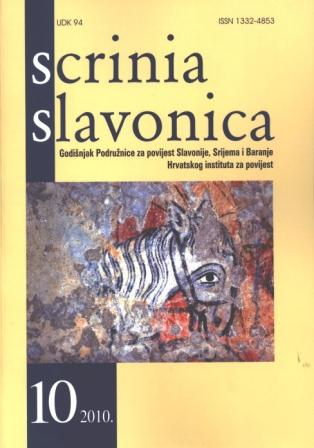Rimske prometnice i komunikacije u kasnoantičkoj južnoj Panoniji .
Roman roads and communications in Late Antique South Pannonia
Author(s): Hrvoje GračaninSubject(s): History
Published by: Hrvatski institut za povijest
Keywords: Roman roads; road stations; South Panonia; late antiquity.
Summary/Abstract: Based on written sources and archeological evidence, as well as relevant historiographic literature, the paper discusses the traffic communications in late antique South Pannonia with special regard to three Roman road axes that existed in that area: the Podravian, the Posavian, and the Danubian (the limes) roads. The vicinal roads are also given the attention, especially the so-called inner road that intersected transversely and longitudinally the interior of the Sava-Drava-Danube interamnium, and connected the central area with main traffic routes. The main focus is on the topographic issues and identification of the network of Roman road stations. Even a glance at the Roman traffic routes recorded in literary sources and established on the ground clearly shows the development of the Roman traffic system in South Pannonia and its functionality in the late antique period. Along with three road axes, the Podravian, the Posavian and the Danubian (the limes) roads, the regional, inner road (via mediterranea) was of paramount importance. No less important were the vicinal roads that connected larger settlements, such as the routes from Marsonia to Certis<i>a or from Aquae Iasae to Iovia Botivum, cut short the lenght of some routes, such as the Posavian road that had an alternative, more straight link to Siscia through modern Turopolje, or directly connected major road links, for example the Aqua Viva-Pir-Andautonia-Siscia and the Bononia-Sirmium roads. These main and principal routes were complemented by a series of minor and secondary roads, which made practically the entire Sava-Drava-Danube interamnium interwoven with road network. Further on-the-ground research should additionally elucidate the courses of already established routes and certainly bring new traffic links to light, especially when it comes to junction towns such as Aquae Iasae, Aquae Balissae and Certis<i>a. Finally, the proposed identification of road stations does not exhaust in any way the possibility of varying hypotheses, particularly with regard to data scarcity and uncertainty of itinerary and other sources, and the fact that the creation of a thorough archaeological picture is still in many ways ahead.
Journal: Scrinia Slavonica
- Issue Year: 2010
- Issue No: 10
- Page Range: 9-69
- Page Count: 61
- Language: Croatian

